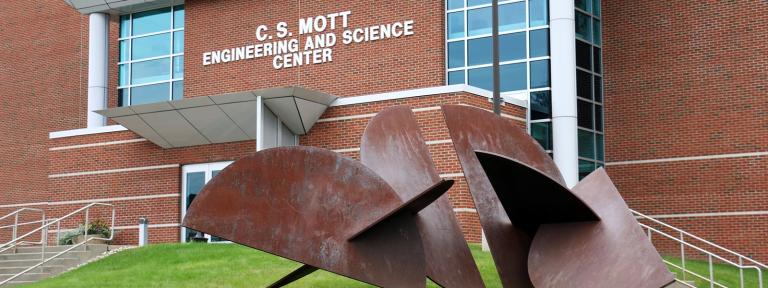
The look will be high-tech and so is the purpose -- Kettering University dedicated a $42 million renovation project June 21 intended to house a new century of science and engineering at one of the country's premier co-op institutions. The facility is the first new academic building at the institution in 70 years.
Ceremonies were conducted at Kettering's new Mechanical Engineering and Chemistry building. The exterior of the building will feature silversmith and slate gray metal panels, streamlining the look of the 1940s block building into a modern engineering center.
"The renovation of this building is a significant step in helping our University build for a new century," said University President James E.A. John. "It serves as an important endorsement of Kettering's top-quality academic programs."
Kettering's new Mechanical Engineering and Chemistry Building is an existing building on campus, located southeast of the Campus Center. When renovation is complete, Kettering's new academic building will have three stories and approximately 126,000 gross square feet. The first classes offered in the new facility will be in July 2003. Architect for the project is Harley Ellis, Southfield, and Construction Manager is Barton Malow, Southfield. The new interior will sport contemporary colors of bianco sardo (off white), labradorite (cobalt blue) and cinnamon (brick red).
The building, which currently has 86,000 square feet on two levels, was built by General Motors Corp. in 1940 and is known as Building 35. Chevrolet Manufacturing used the facility as a customer delivery unit. Early prototype work on the Corvette was completed in the building, which was later used by AC Delco and then donated to the University by Delphi Automotive Systems in 1996.
A portion of the first floor is already in use, housing an automotive engine test cell, instrumentation and control equipment designed in collaboration with Lubrizol. The first floor is also home to an undergraduate automotive design center, where vehicles for the Society of Automotive Engineers (SAE) and other intercollegiate competitions are designed and fabricated. In the future, it will also house automotive laboratories.
The second floor will be the new home of Kettering's Mechanical Engineering Department, including laboratories and faculty and departmental offices. A third floor will be added to the structure for Chemistry classrooms, laboratories and faculty and departmental offices.
Mechanical Engineering will move into lab and classroom spaces that are more than 47,500 square feet, a 25 percent increase from its current facilities. The chemistry program will more than double its current space to 24,000 square feet. Automotive lab facilities will ultimately triple its current space to more than 32,000 square feet, when completed.
"At a time when many of our competitor schools in engineering and science are putting up new facilities, we will be able to compete with new laboratories in a building with a modern infrastructure," President John said. "All students at Kettering take chemistry; our new chemistry laboratories will be state-of-the-art and will be of great benefit."
John noted that Kettering is a top producer of undergraduate mechanical engineers and the new laboratories are essential to maintain the University's competitive position. "Our new laboratories will enable us to compete for applied research contracts with our corporate partners and will add a new dimension to our University," he said.